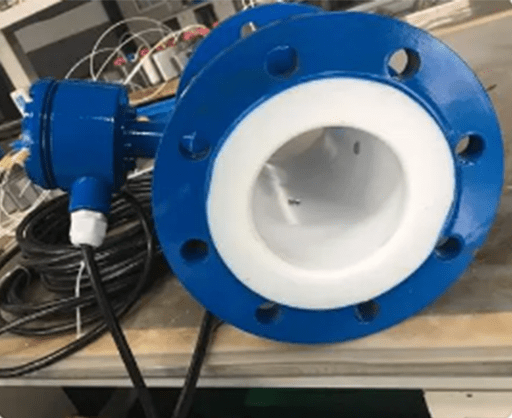
Figure 1: An electromagnetic flowmeter.
Electromagnetic flowmeter can be used for volume flow measurement of water. It not only has the advantages of small pressure loss and large measurable range, but also has simple structure and stable performance. It is now one of the more common flow measurement instruments on the market.
1. Structure
The structure of electromagnetic flowmeter is mainly composed of magnetic circuit system, measuring catheter, casing, lining and converter.

Figure 2: The structure of electromagnetic flowmeter.
1.1 Magnetic Circuit
Its function is to produce a uniform DC or AC magnetic field. The DC magnetic circuit is realized by permanent magnet which has the advantages of simple structure and less interference by AC magnetic field. But it is easy to polarize the electrolyte liquid in the measuring catheter. So, the positive electrode is surrounded by negative ions and the negative electrode is surrounded by positive ions. The polarization phenomenon of the electrode leads to the increase of internal resistance between the two electrodes seriously affecting the normal operation of the instrument. When the pipe diameter is large, the permanent magnet is also large. In this case, it is bulky and uneconomical, so the electromagnetic flowmeter generally adopts alternating magnetic field and is excited by 50Hz power frequency power supply.
1.2 Measuring Catheter
Its function is to let the measured conductive liquid pass through. In order to make the magnetic flux shunted or short circuited when the magnetic force line passes through the measuring conduit, the measuring catheter must be made of materials with non-magnetic conductivity, low conductivity, low thermal conductivity and certain mechanical strength. Such as non-magnetic stainless steel, FRP, high-strength plastic, aluminum, etc.
1.3 Electrode
Its function is to lead out the induced potential signal proportional to the measured. The electrodes are generally made of non-magnetic stainless steel and are required to be flush with the lining so that the passage of fluid is not obstructed. Its installation position should be in the vertical direction of the pipeline to prevent sediment from accumulating on it and affecting the measurement accuracy.
1.4 Casing

Figure 3: The casing of electromagnetic flowmeter.
It shall be made of ferromagnetic material. It is the housing of the distribution system excitation coil and isolates the interference of the external magnetic field.
1.5 Lining
There is a complete layer of electrical insulation lining on the inner side of the measuring catheter and the flange sealing surface. It is in direct contact with the measured liquid. Its function is to increase the corrosion resistance of the measuring catheter and prevent the induced potential from being short circuited by the pipe wall of it. The lining materials are mostly corrosion-resistant, high temperature resistant and wear-resistant Teflon plastics, ceramics, etc.
1.6 Converter
The induced potential signal generated by liquid flow is very weak and greatly affected by various interference factors. The function of the converter is to amplify and convert the induced potential signal into a unified standard signal and suppress the main interference signal. Its task is to amplify and convert the induced potential signal Ex detected by the electrode into a unified standard DC signal.
2. Working Principle

Figure 4: The lining of electromagnetic flowmeter.
Electromagnetic flowmeter operates on the principle of Faraday's law of electromagnetic induction. The law is named after the British scientist Michael Faraday, who studies the effect of magnetic fields on circuits. The fundamental law of electromagnetism predicts how magnetic fields interact with circuits to produce electromotive force. This phenomenon is called electromagnetic induction.
In short, when a conductive object (or fluid) moves in a magnetic field, it will generate electromotive force (voltage). The magnitude of the induced voltage is directly proportional to the speed of the conductor (or fluid), the width of the conductor and the strength of the magnetic field. By establishing a circuit across a magnetic field (through a conductor), the amount of voltage generated by the movement of the conductor can be collected and measured. The measurement is proportional to the velocity of the fluid. In the electromagnetic flowmeter, the electronic equipment controls the magnetic field by providing a stable current for the metal wound coil, which is used to measure the induced voltage generated by the conductive liquid.
Many liquids are conductive, and water with dissolved ionic particles, such as impurities or chlorine, becomes more conductive depending on the number of particles per gallon. This makes the electromagnetic flowmeter an effective choice for measuring the flow in water and wastewater treatment plants.
Related Info
What is a centrifugal fanHow to make an air conditioner with a fan
How to make a fan blow cold air


